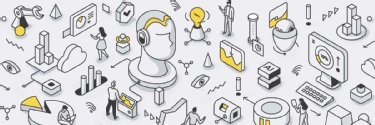Digital transformation
Digital transformation is a means of using digital technologies to innovate operations, products, services and processes and improve employee and customer experience. Here you can read news, guides and tips on how to lead digital transformation efforts. Learn how blockchain, AI, automation technologies and other tech fits into transformation projects.
Top Stories
-
Tip
13 Jan 2026

Deepfake phishing is here, but many enterprises are unprepared
Deepfake phishing attacks are on the rise, as attackers use AI to deceive and defraud end users and their employers. Learn what CISOs can do to protect their organizations. Continue Reading
By- Amy Larsen DeCarlo, GlobalData
-
Feature
07 Jan 2026

Top 9 blockchain platforms to consider in 2026
Get the lowdown on the major features, differentiators, strengths and weaknesses of the blockchain platforms that are getting the most buzz -- and real-world deployments. Continue Reading
-
Feature
02 Jan 2026

The top 6 content management trends in 2026
AI technology continues to shape the content management market. It underpins top trends in 2026, including generative AI, agentic AI and predictive analytics. Continue Reading
By -
Feature
30 Dec 2025

AI surge fuels dramatic transformation of CIO role
As AI continues to move into the enterprise, the CIO's role is rapidly expanding into AI leadership, scaling AI responsibly and delivering measurable business value. Continue Reading
-
Feature
26 Dec 2025

The 2026 talent reckoning: Beyond degrees and certifications
Skills, not degrees, will define IT hiring in 2026. CIOs are shifting from degree-based hiring to skills-based strategies, using AI and microcredentials to retain top IT talent. Continue Reading
By- Rosa Heaton, Content Manager
-
Feature
24 Dec 2025

From CIO to CEO: Unlocking the entire C-suite
CIOs can evolve from technology leaders to enterprise strategists, taking on higher C-suite roles by building profit and loss fluency, influence, and leadership skills. Continue Reading
By- Rosa Heaton, Content Manager
-
Tip
12 Dec 2025

Top metaverse platforms in 2026, rise of spatial computing
The metaverse is evolving, beginning with its rebranding as spatial computing and its expansion into the workplace. Here are 15 metaverse platforms to watch in 2026. Continue Reading
By- Esther Shein
- Tim Murphy, Site editor
-
Feature
26 Nov 2025

Top 12 business process management certifications for 2026
These certifications and courses can help you gain the specialized knowledge you need to bolster your credentials and marketability as a BPM professional. Continue Reading
By- Rosa Heaton, Content Manager
- Andy Patrizio
-
Tip
25 Nov 2025

Meet quantum needs with hybrid digital infrastructure
The potential for quantum computing remains unparalleled. Does your organization understand the demands quantum computing will have on digital infrastructure? Continue Reading
By -
Feature
12 Nov 2025

17 real-world use cases of the metaverse, plus examples
Use cases for the still-developing metaverse are growing as the technologies that enable this next iteration of the internet mature. Here are 17 examples of enterprises and consumers. Continue Reading
-
Definition
31 Oct 2025

What is a chief data officer (CDO)?
A chief data officer (CDO) in many organizations is a C-level executive whose position has evolved into a range of strategic data management responsibilities, including data governance, data quality and data strategy. Continue Reading
By- Paul Kirvan
- Mary K. Pratt
- Ron Karjian, Industry Editor
-
Definition
30 Oct 2025

What is user-generated content?
User-generated content (UGC) is published information that an unpaid contributor provides to a website. Continue Reading
By- Paul Kirvan
- Kinza Yasar, Technical Writer
- Rachel Lebeaux
-
Definition
28 Oct 2025

What is business process outsourcing (BPO)?
Business process outsourcing (BPO) is a business practice in which an organization contracts with an external service provider to perform an essential business function or task. Continue Reading
By- Rahul Awati
- Alexander S. Gillis, Technical Writer and Editor
- Mary K. Pratt
-
Feature
24 Oct 2025

CIOs must lead workforce transformation in AI era
AI workforce transformation requires careful education, strategic CIO leadership and balanced implementation to empower employees while managing inevitable organizational changes. Continue Reading
By- Jim O'Donnell, News Director
-
Tip
21 Oct 2025

How to present to the board of directors: 15 tips for a successful presentation
A board presentation can influence major decisions. Follow these 15 expert tips from Metrigy CEO and principal analyst Robin Gareiss to deliver a successful presentation. Continue Reading
By- Robin Gareiss, Metrigy
- Alexander S. Gillis, Technical Writer and Editor
-
Definition
09 Oct 2025

What is a communication service provider (CSP)?
Communication service provider (CSP) is a broad category of companies that deliver telecommunications, including broadcast and two-way communications services. Continue Reading
By -
Definition
06 Oct 2025

What is Hyperledger?
Hyperledger is a collection of open source projects created to support the development of blockchain-based distributed ledgers. Continue Reading
By- Alexander S. Gillis, Technical Writer and Editor
-
Definition
12 Sep 2025

What is enterprise architecture (EA)?
An enterprise architecture (EA) is a conceptual blueprint that defines an organization's structure and operation. Continue Reading
By- Nick Barney, Technology Writer
- Alexander S. Gillis, Technical Writer and Editor
-
Feature
11 Sep 2025

10 examples of smart contracts on blockchain
Smart contracts are powerful tools for automating tasks on a blockchain. Read these use cases and understand the benefits and challenges IT leaders face during implementation. Continue Reading
By- Eric St-Jean
- Guilliean Pacheco, Associate Site Editor
-
Tip
27 Aug 2025

Project vs. program vs. portfolio management, explained
Project, program and portfolio management are related, but they represent three distinct disciplines. Learn about the responsibilities and goals of each and how they differ. Continue Reading
By -
Feature
26 Aug 2025

Capital One AI partnerships aim to build trust, grow talent
Capital One's relationships with the National Science Foundation and several universities seek to improve AI's responsiveness and create new metrics to measure its progress. Continue Reading
By- John Moore, Industry Editor
-
Tip
26 Aug 2025

10 free IT strategic planning templates and examples for CIOs
As technology becomes a business differentiator, a well-thought-out IT strategy plan is more crucial than ever. These IT strategy templates help CIOs make IT a business driver. Continue Reading
By- Kinza Yasar, Technical Writer
- Linda Tucci, Industry Editor -- CIO/IT Strategy
-
Tip
14 Aug 2025

How to remove digital signatures from a PDF
Digital signatures let organizations execute and secure agreements, but users can remove them if they need to reformat documents or protect signers' privacy. Continue Reading
By -
Feature
04 Aug 2025

Why digital literacy in the workplace is important
Some examples of digital literacy that are necessary for the contemporary workplace are knowing how to use Excel and generative AI. Learn more about why digital literacy matters. Continue Reading
-
Feature
23 Jul 2025

Top 10 crypto influencers to follow on social media
As cryptocurrency surges in popularity, finding trustworthy sources of information is essential. These thought leaders offer diverse perspectives to stay on top of market trends. Continue Reading
By- Tommy Everson, Assistant Editor
-
News
26 Jun 2025

Fair use rulings favor Meta and Anthropic but are limited
While the judges agreed with the fair use argument, it doesn't mean other lawsuits will have the same ruling. It's also likely that the Supreme Court will be the ultimate decider. Continue Reading
By- Esther Shittu, News Writer
-
Tip
26 Jun 2025

12 ERP KPIs for post-implementation success
Learn the metrics that help IT teams assess whether an ERP system has helped to streamline processes and improve overall business performance. Continue Reading
By -
Definition
12 Jun 2025

What is a chief product officer (CPO)?
A chief product officer (CPO) is a C-level executive responsible for the overall product strategy, development, and performance within an organization. Continue Reading
-
Feature
10 Jun 2025

The history of quantum computing: A complete timeline
The theories behind quantum computing go back decades, but progress has accelerated in the 2000s. Know the key milestones to get a quick understanding of how quantum developed. Continue Reading
-
Definition
09 Jun 2025

What is the Fourth Industrial Revolution?
The Fourth Industrial Revolution (4IR) is the ongoing transformation of how people live, work and relate to one another through the fusion of technologies that blur the lines between the physical, digital and biological spheres. Continue Reading
-
Definition
04 Jun 2025

What is VR locomotion (virtual reality locomotion)?
VR locomotion refers to the techniques and technologies that allow users to move within a virtual reality (VR) environment. Continue Reading
-
Tip
04 Jun 2025

A guide to risk registers: Benefits and examples
Risk registers document, prioritize and track an organization's risks, providing a holistic view of the risks and a ready way to communicate risk strategies. Continue Reading
-
Feature
22 May 2025

Risk appetite vs. risk tolerance: How are they different?
Risk appetite and risk tolerance are related, but they don’t mean the same thing. Not knowing the difference can cause big problems for your risk management program. Continue Reading
By- Mike Chapple, University of Notre Dame
-
Definition
21 May 2025

What is crowdsourcing?
Crowdsourcing is the practice of turning to a body of people to obtain needed knowledge, goods or services. Continue Reading
By- Mary K. Pratt
- Chris Gonsalves, TechTarget
-
News
20 May 2025

Early-stage tech companies comb through data, software code
Software startups participating in the 2025 MIT Sloan CIO Symposium's Innovation Showcase take on the challenge of picking out the key signals from vast amounts of data. Continue Reading
By- John Moore, Industry Editor
-
Definition
15 May 2025

What is systems thinking?
Systems thinking is a holistic approach to analysis that focuses on the way that a system's constituent parts interrelate and how systems work over time and within the context of larger systems. Continue Reading
By- Ben Lutkevich, Site Editor
-
Definition
13 May 2025

What is IT asset management (ITAM)?
IT asset management (ITAM) is a set of business practices that combines financial, inventory and contractual functions to optimize spending and support lifecycle management and strategic decision-making within the IT environment. Continue Reading
By- Paul Kirvan
- Reda Chouffani, Biz Technology Solutions
- Brian Holak
-
Definition
13 May 2025

What is the consumerization of IT (IT consumerization)?
The consumerization of IT refers to how software and hardware products designed for personal use have migrated into the enterprise and are used for work purposes. Continue Reading
By- Rahul Awati
- George Lawton
- Linda Tucci, Industry Editor -- CIO/IT Strategy
-
Feature
12 May 2025

RIT showcase offers glimpse of early tech innovation cycle
Connected vehicle security, AI and 3D printing were among the technologies featured at Imagine RIT, an annual exhibition focusing on student and faculty innovation. Continue Reading
By- John Moore, Industry Editor
-
Definition
08 May 2025

What is a change agent (agent of change)?
A change agent, or agent of change, is someone who promotes change and enables it to happen within any group or organization. Continue Reading
By- Katie Terrell Hanna
- Ben Lutkevich, Site Editor
- Mary K. Pratt
-
Tip
07 May 2025

CIO vs. CTO: Key differences in roles and responsibilities
The emergence of IT and its ever-increasing importance to enterprise operations led to the creation of two tech exec positions with similar duties: the CIO and the CTO. Continue Reading
-
Feature
07 May 2025

Enterprise risk management team: Roles and responsibilities
Every facet of business operations is exposed to risks, requiring a risk management team that's composed of a diverse mix of corporate executives and managers. Continue Reading
By -
Feature
06 May 2025

Emerging technologies in construction help manage work, risk
Emerging technologies in construction include AI and digital twins. Read how companies use advanced IT to improve risk analysis, forecasting, and more. Continue Reading
By- John Moore, Industry Editor
-
Definition
30 Apr 2025

What is quantum error mitigation?
Quantum error mitigation is a process used to reduce the impact of errors in quantum computing. Continue Reading
By- Alexander S. Gillis, Technical Writer and Editor
-
Definition
30 Apr 2025

What is a CIO (chief information officer), and what do they do?
The role of the CIO emerged in the late 1950s, when businesses began to incorporate computing into business operations. Continue Reading
-
Definition
28 Apr 2025

What is Willow? Google's innovative quantum chip explained
Willow is a quantum computing chip made by Google that was unveiled at the end of 2024. Continue Reading
By- Alexander S. Gillis, Technical Writer and Editor
-
Definition
25 Apr 2025

What is quantum computing? How it works and examples
Quantum computing is an emerging area of computer science focused on building computers based on the principles of quantum theory to dramatically increase computation speeds. Continue Reading
By- David Essex, Industry Editor
- Alexander S. Gillis, Technical Writer and Editor
-
Tip
24 Apr 2025

The top quantum computing jobs in 2025
Quantum research is a growing field with several available career paths for tech professionals, including quantum software engineer and quantum application specialist. Continue Reading
By- Madeleine Streets, Senior content manager
-
Tip
24 Apr 2025

Compare 7 decentralized data storage networks
Decentralized storage offers organizations an alternative to centralized cloud storage. While cost can be a benefit, support levels vary among some of the top vendors. Continue Reading
-
Definition
22 Apr 2025

What is business transformation?
Business transformation refers to fundamental changes in an organization’s operations, strategy or structure to improve efficiency, competitiveness and financial performance. Continue Reading
-
Feature
22 Apr 2025

9 quantum computing challenges IT leaders should know
While the theory of quantum mechanics is complex, the technology might offer practical uses for organizations. Learn about the challenges and opportunities of quantum computing. Continue Reading
-
Tip
17 Apr 2025

How quantum computing can improve supply chains
Quantum's ability to model and analyze complex scenarios is tailor-made for tasks like route optimization and inventory management. Apps exist, but wide availability is years away. Continue Reading
-
Feature
17 Apr 2025

The potential business opportunities in quantum computing
Optimization use cases in areas like supply chain, resource allocation, routing and production scheduling are leading the near-term commercial application of quantum computing. Continue Reading
-
Feature
17 Apr 2025

10 online digital transformation certifications and courses
Whether you're an aspiring IT pro or an experienced business leader, these digital transformation certificates offer an opportunity to gain valuable skills. Continue Reading
By- Mary K. Pratt
- Linda Tucci, Industry Editor -- CIO/IT Strategy
- Gabriella Frick
-
Feature
15 Apr 2025

Quantum AI: Explaining how it will impact the business world
Quantum computers could boost AI with faster training on big data and better problem-solving abilities. But combining the two in practical business applications could take years. Continue Reading
By -
Definition
14 Apr 2025

What is e-business?
E-business (electronic business) is the conduct of online business processes on the web, internet, extranet or a combination thereof. Continue Reading
By- Nick Barney, Technology Writer
- Mary K. Pratt
- Ben Cole, Executive Editor
-
News
11 Apr 2025

DARPA quantum computing benchmark test seeks 'utility scale'
DARPA aims to evaluate up to 20 vendors -- from startups to large tech companies -- using a benchmarking framework that spans multiple types of quantum computing. Continue Reading
By- John Moore, Industry Editor
-
Definition
10 Apr 2025

What is digital disruption?
Digital disruption is the change that occurs when new digital technologies and business models affect the value proposition of existing goods and services. Continue Reading
By- Linda Tucci, Industry Editor -- CIO/IT Strategy
-
Opinion
08 Apr 2025

The state of quantum computing: What businesses need to know
Quantum computing's potential and steady advancement make the technology worth investigating, but adopters still need to deal with conflicting claims and uncertain market timing. Continue Reading
By- John Moore, Industry Editor
-
Tip
04 Apr 2025

Quantum computing in finance: Key use cases
The financial services industry could soon use quantum for portfolio management, fraud detection and other complex processes. But the list of hurdles to overcome is long. Continue Reading
-
Feature
03 Apr 2025

Low code vs. BPM: Differences and similarities
Low-code development and business process management help digitize and optimize business operations. Learn how each works and how together they enable digital transformation. Continue Reading
-
Definition
02 Apr 2025

What is wearable technology? Definition, uses and examples
Wearable technology is any kind of electronic device designed to be worn on the user's body. Continue Reading
By- Katie Terrell Hanna
- Kinza Yasar, Technical Writer
-
Feature
31 Mar 2025

What are the 4 different types of blockchain technology?
Each blockchain network has distinct pluses and minuses that largely drive its ideal uses. Continue Reading
By- Christine Campbell, The Alpha Content Company
- Guilliean Pacheco, Associate Site Editor
-
Tip
28 Mar 2025

The 6 different types of quantum computing technology
Technology providers offer several paths to the promised land of quantum advantage, but customers must navigate the engineering tradeoffs among the varied types of qubits. Continue Reading
By- John Moore, Industry Editor
-
Tip
21 Mar 2025

How can quantum computers be used in healthcare?
Commercial products are few, and wide availability is probably a few years away, but lab research and prototypes show progress in drug design, medical imaging and genetic modeling. Continue Reading
By -
Tip
21 Mar 2025

When will quantum computing be available? It depends
Quantum computing availability timelines depend on who is measuring and how they interpret 'availability.' Varied definitions make for a complex market. Continue Reading
By- John Moore, Industry Editor
-
Tip
17 Mar 2025

Quantum computer vs. supercomputer: Key differences
Quantum computers could someday outperform supercomputers by orders of magnitude. Compare speeds, capabilities and specialties, and get a look into a future that combines the two. Continue Reading
-
Definition
13 Mar 2025

What is ICT (information and communications technology)?
ICT (information and communications technology) is the infrastructure and components that enable modern computing. Continue Reading
-
Feature
07 Mar 2025

Top 5 metaverse conferences in 2025
The metaverse offers businesses unique training and customer service opportunities. Here are some events where you can learn more about this immersive technology and how to use it. Continue Reading
By- Rosa Heaton, Content Manager
- Amanda Hetler, Senior Editor
-
Definition
05 Mar 2025

What is emotional intelligence (EI)?
Emotional intelligence (EI) is the area of cognitive ability that facilitates interpersonal behavior. Continue Reading
By- Ben Cole, Executive Editor
-
Feature
27 Feb 2025

Enterprise AI strategy surges in importance for IT buyers
Organizations have sharply elevated the business importance of AI and machine learning technologies, according to Informa TechTarget's survey on 2025 IT spending plans. Continue Reading
By- John Moore, Industry Editor
-
News
13 Feb 2025

IT orgs expand business observability beyond their own walls
Business observability could soon become a part of your IT environment, even if you're not the one who originally thought of it. Continue Reading
By- Beth Pariseau, Senior News Writer
-
Definition
07 Feb 2025

What is cognitive automation?
Cognitive automation describes diverse ways of combining artificial intelligence (AI) and process automation capabilities to improve business outcomes. Continue Reading
-
Tip
03 Feb 2025

8 generative AI challenges that businesses should consider
IT managers planning to adopt GenAI can expect to encounter some hurdles, including cost optimization, workforce effects, cybersecurity concerns and energy use. Continue Reading
By- John Moore, Industry Editor
-
Tip
30 Jan 2025

10 top generative AI benefits for business
The advantages of using generative AI cover plenty of ground, with improving customer experience, reducing costs and automating code creation among the key drivers. Continue Reading
By- John Moore, Industry Editor
-
Definition
30 Jan 2025

What is blockchain? Definition, examples and how it works
Blockchain is a distributed ledger technology (DLT) that's shared across a network of computers to keep a digital record of transactions. Continue Reading
By- Kinza Yasar, Technical Writer
- Nick Barney, Technology Writer
- Mary K. Pratt
-
Podcast
28 Jan 2025

8 steps to build a successful AI strategy for your business
Customer AI strategist Bill Schmarzo explains how organizations can successfully implement AI by focusing on people, process and purpose over technology. Continue Reading
By- Ana Salom-Boira, Editorial Manager -- Content Innovation
-
News
24 Jan 2025

Gartner tech spending forecast tempered by price hikes
The global IT market is projected to grow 9.8% in 2025, but an expected increase in the prices of vendor products and services will eat into CIOs' tech budgets. Continue Reading
By- John Moore, Industry Editor
-
Tip
23 Jan 2025

12 top business process management tools for 2025
BPM platforms are becoming a business transformation engine as vendors infuse their tools with powerful AI and automation capabilities. Read our review of top BPM products. Continue Reading
By- Dan Morris, Wendan Consulting
-
Tip
17 Jan 2025

10 trends shaping the future of BPM in 2025
Business process management is evolving rapidly as advanced automation, software integration, process simulation and generative AI redefine the way business processes are managed. Continue Reading
-
Definition
13 Jan 2025

What is Reddit? How it works, history and pros and cons
Reddit is a social media platform and forum-style website where content is socially curated and promoted by site members through voting. Continue Reading
By- Kinza Yasar, Technical Writer
- Christian Stafford, Editorial Assistant
-
Feature
06 Jan 2025

12 must-know blockchain trends for 2025 and beyond
The over-the-top hype faded years ago, but blockchain is settling in to make steady advances in cryptocurrency, financial services, tokenization and digital verification. Continue Reading
-
Tip
03 Jan 2025

Top Web 3.0 trends and predictions for 2025 and beyond
The next-generation internet is taking longer than expected. But blockchain improvements and a favorable regulatory climate for cryptocurrency are positives for the coming year. Continue Reading
-
Definition
03 Jan 2025

What is a CVO (chief visionary officer)?
The CVO (chief visionary officer) is a newer C-suite title where the holder is expected to have a broad and comprehensive knowledge of all matters related to the business of the organization, as well as the vision required to steer its course into the future. Continue Reading
-
Tip
02 Jan 2025

Top 7 CIO challenges in 2025 and how to handle them
AI colors nearly all the top CIO concerns for 2025. When they are not deploying AI, they'll be tidying data to fuel AI projects and balancing AI against digital transformation. Continue Reading
By- John Moore, Industry Editor
-
Tip
02 Jan 2025

8 factors reshaping the role of the CIO in 2025
Bring us the money. Heading into 2025, CIOs face increasing pressure to drive revenue, savings and business value from their technology initiatives, particularly in AI. Continue Reading
-
Feature
02 Jan 2025

Top 5 digital transformation trends of 2025
IT leaders can expect AI to occupy the transformation driver's seat as the technology moves into production and embeds itself in enterprise workflows. Continue Reading
By- John Moore, Industry Editor
-
Definition
30 Dec 2024

What is a balanced scorecard and how does the methodology work?
The balanced scorecard is a management system aimed at translating an organization's strategic goals into a set of organizational performance objectives that, in turn, are measured, monitored, and changed, if necessary, to ensure that organizational goals are met. Continue Reading
By- Linda Tucci, Industry Editor -- CIO/IT Strategy
- Katie Terrell Hanna
-
Definition
27 Dec 2024

What is Six Sigma and how does it work?
Six Sigma is a business methodology for quality improvement that measures how many defects there are in a current process and seeks to systematically eliminate them. Continue Reading
By- Katie Terrell Hanna
- Emily McLaughlin, Coravin
-
Tip
23 Dec 2024

9 must-read digital transformation books in 2025
Digital transformation is crucial for businesses wanting to keep up with technological growth. Start your digital transformation journey with this list of essential books for 2025. Continue Reading
-
Feature
23 Dec 2024

6 must-read blockchain books for 2025
Numerous sources provide comprehensive information on blockchain fundamentals and applications. We narrowed the field to six of the most popular and diverse books available. Continue Reading
By- Kinza Yasar, Technical Writer
-
Definition
11 Dec 2024

What is an AI assistant?
An AI assistant, or digital assistant, is software that uses artificial intelligence to understand natural language voice commands and complete tasks for the user. Continue Reading
By- Scott Robinson, New Era Technology
- Kinza Yasar, Technical Writer
- Bridget Botelho, Editorial Director, News
-
Definition
02 Dec 2024

What is the digital divide?
The digital divide is the gap between demographics and regions that have access to modern information and communications technology (ICT) and those with no or restricted access. Continue Reading
-
News
02 Dec 2024

Editor's Note: Expansion means broader expert coverage for you
Starting today, the new Informa TechTarget will double editorial coverage, broaden topics covered, deliver deeper expert insights to tech content consumers. Continue Reading
By- Kelley Damore, Chief Content Officer
-
Definition
26 Nov 2024

What is augmented intelligence?
Augmented intelligence is the use of technology to enhance a human's ability to execute tasks, perform analysis and make decisions. Continue Reading
By- Alexander S. Gillis, Technical Writer and Editor
- George Lawton
-
Definition
26 Nov 2024

What is a Request for Comments (RFC)?
A Request for Comments (RFC) is a formal document created by the Internet Engineering Task Force (IETF) that outlines technical specifications, organizational notes and standards relevant to internet and networking technologies, including protocols such as routing, addressing and transport technologies. Continue Reading
-
Definition
25 Nov 2024

What is a support vector machine (SVM)?
A support vector machine (SVM) is a type of supervised learning algorithm used in machine learning to solve classification and regression tasks. Continue Reading
By- Kinza Yasar, Technical Writer
- Fred Tabsharani, Loxz Digital Group
-
Definition
25 Nov 2024

What is a convolutional neural network (CNN)?
A convolutional neural network (CNN) is a category of machine learning model. Specifically, it is a type of deep learning algorithm that is well suited to analyzing visual data. Continue Reading
By- Alexander S. Gillis, Technical Writer and Editor
- Lev Craig
- Rahul Awati
-
Definition
21 Nov 2024

What is neuro-symbolic AI?
Neuro-symbolic AI combines neural networks with rules-based symbolic processing techniques to improve artificial intelligence systems' accuracy, explainability and precision. Continue Reading
-
Definition
21 Nov 2024

What is Dall-E and how does it work?
Dall-E is a generative artificial intelligence (AI) technology that enables users to create images by submitting text-based prompts. Continue Reading
-
Tip
19 Nov 2024

Best project portfolio management software and tools in 2025
Project portfolio management software and tools in 2025 promote strategic management of projects and agile tactics. Read our PPM list for guidance on which tools do what. Continue Reading
-
Tip
12 Nov 2024

5 principles of change management in networking
Network change management includes five principles, including risk analysis and peer review. These best practices can help network teams reduce failed network changes and outages. Continue Reading
By- Terry Slattery, NetCraftsmen